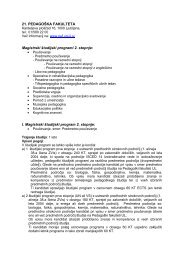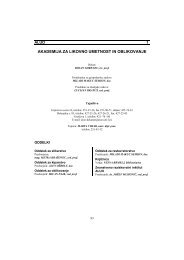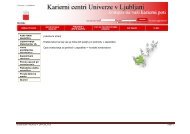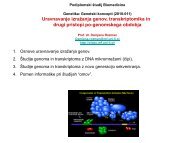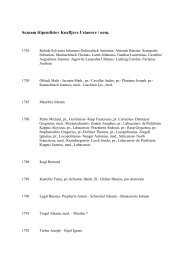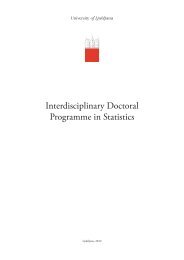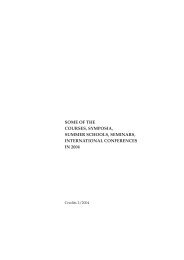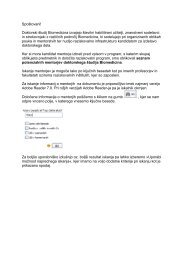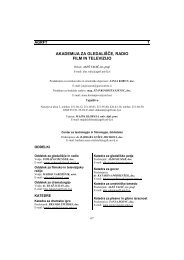Medicinska fakulteta Univerze v Ljubljani 1919–1945 - Univerza v ...
Medicinska fakulteta Univerze v Ljubljani 1919–1945 - Univerza v ...
Medicinska fakulteta Univerze v Ljubljani 1919–1945 - Univerza v ...
You also want an ePaper? Increase the reach of your titles
YUMPU automatically turns print PDFs into web optimized ePapers that Google loves.
We can say that there was a medical-surgical school at the Lyceum<br />
in Ljubljana that was organised as a special vocational school<br />
that was supposed to educate medical staff of the lower order<br />
after a quick study course, which was especially true of the first<br />
Pre-March Period�<br />
The number of doctors in Austria at the time was extremely<br />
low� Doctors with PhD degrees were only available in cities�<br />
Even though medical-surgical studies were not aiming to train<br />
for scientific work, the example of the study in Ljubljana shows<br />
that it was here that these studies “achieved a high level of<br />
scientific endeavour”� The opinion supported by the Carniolan<br />
Protomedicus (chief physician in the country), Dr� Anton Jožef<br />
Haymann as well as van Swieten and assistant Dr� Anton von<br />
Stoerck, that lyceum teachers were not appointed for scientific<br />
work, but rather for practical medical work (training useful<br />
obstetrics assistants and candidates for graduation, and teaching<br />
medical treatment skills), was not heeded by the teachers<br />
of medicine and surgery in Ljubljana� A number of teachers<br />
teaching medical-surgical studies in Ljubljana began their professional<br />
career at the lyceum, e�g� Baltazar Hacquet, Dr� Vincenc<br />
Kern, Dr� Joseph Wattmann, Dr� Franz Fikelscherer, Dr� Kristjan<br />
August Voigt and Dr� Bernard Pachner Freiherr Eggenstorf� After<br />
this, they went on to pursue academic careers at various universities�<br />
While faculties were awarding doctoral titles to Doctor<br />
of Medicine and Master of Surgery and Obstetrics candidates,<br />
graduation candidates of medical-surgical studies were graduating<br />
only as Patrons of Surgery who performed their duties as civilian<br />
or rural barber surgeons (Civil- und Landwundärzte)�<br />
Just as apprentices in other professions, surgeons had to learn<br />
their trade at their master’s during the times of Joseph II, while a<br />
future Patron of Surgery was now required to complete medicalsurgical<br />
studies� Acceptance to the school was, of course, available<br />
to students who completed three years of apprenticeship with a<br />
surgeon, the model elementary school or the general elementary<br />
school (type of lower-level gymnasium), while it was only from<br />
1833 onwards that enrolment required four years of grammar<br />
school or gymnasium or three years of the model elementary<br />
school� Throughout the entire Austrian Pre-March Period,<br />
enrolment to medical-surgical study did not require a gymnasium-level<br />
education, which was required for the other studies at<br />
the lyceum�<br />
In the beginnings of surgery studies at lyceums, academic<br />
performance was poor� “It was especially Ljubljana that was<br />
reputed for having a very small number of students finish the<br />
school there and many such who were sitting in the same class for<br />
several years� This is, of course, a reflection of the fact that access<br />
to the school was also available to students, of whom not much<br />
else could be expected?”<br />
In accordance with the generally valid regulations governing<br />
examinations, learners of the medical-surgical studies at the<br />
Ljubljana Lyceum had to pass semestrial and annual examinations,<br />
99<br />
while they had to undergo an examination before a commission<br />
after they completed their second year of study� The commission<br />
was composed of both the teachers of medical-surgical studies<br />
and two randomly selected city surgeons� After the examinations,<br />
commission members signed the diploma (school leaving<br />
certificate) and the candidates took an oath� Prior to the<br />
examination, candidates also had to state the place they would<br />
undergo internship� In 1807, a reform of medical examinations<br />
was implemented that also applied to the medical-surgical studies<br />
at lyceums: semestrial examinations were abolished, candidates<br />
had to pass a rigorous examination in surgery and obstetrics as well<br />
as a final examination� Grades (grading classes) received for the<br />
rigorous examination in surgery and obstetrics had to be indicated<br />
in the school leaving certificate (diploma)� Learners of medicalsurgical<br />
studies who did not pass the rigorous examination in<br />
surgery were forbidden from practicing any medicine� Medicalsurgical<br />
schools experienced new development with the abovementioned<br />
curriculum from 1810� According to that curriculum,<br />
instruction in the first year encompassed the following courses:<br />
Brief Introduction to the Study of Surgery (Encyclopaedic<br />
Overview and Methodology), Anatomy, Theoretical Surgery,<br />
Physiology, General Pathology and Therapy for Internal Diseases,<br />
Materiam Medicam Et Chirurgicam, Dietetics and the Science<br />
of Prescription Compounding, Science of Wound Dressing and<br />
Instruments� In the second year, it encompassed the following<br />
courses: Instruction on Surgical Operations (demonstrated on<br />
a cadaver), Practical Bedside Surgery Instruction and Exercises,<br />
Forensic Medicine, Special Therapy for Internal Diseases And<br />
Practical Bedside Exercises, Surgical Special Therapy, Practical<br />
Instruction in Surgery and Bedside Exercises, Obstetrics and<br />
Veterinary Science�<br />
This reform of the study of medicine in Ljubljana was only<br />
implemented after the departure of the French and after Austrian<br />
authority was reinstituted� It was then that five professors were<br />
appointed: an anatomist, an internist, a surgeon, an obstetrician<br />
and a veterinarian� Because competitions for the tendered<br />
positions were not always successful, other teachers had to teach<br />
additional courses� In 1813, the course Resuscitation of the<br />
Clinically Dead and First Aid was reintroduced� These lectures<br />
were intended for the broader audience and were provided freeof-charge<br />
in the afternoons on Sundays� The course was taught by<br />
a forensic medicine teacher�<br />
As already mentioned, medical-surgical studies were again<br />
reformed in 1833; conditions for enrolment became stricter and<br />
studies for all candidates lasted three years� The reform prescribed<br />
the following curriculum:<br />
First year<br />
a) Introduction to the Study of Surgery<br />
b) Anatomy<br />
c) Dissection Exercises



